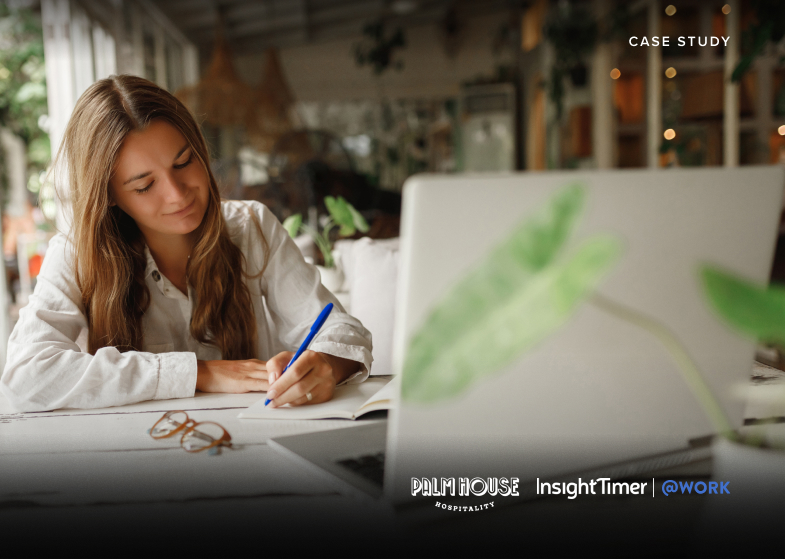For Lucia Pham, building a daily meditation practice was the answer to having a sustainable, fulfilling finance career. It taught her to slow down and manage stress.
The personal practice became a gateway for something greater as she started guiding yoga classes and meditations for colleagues. We spoke with Lucia about how she started her practice on Insight Timer and created community around it at work.
INSIGHT TIMER: How did you decide to try meditation?
Lucia Pham: I started my yoga and meditation practice a long time ago based on the desire to find inner peace. I wanted to find pause in a very fast paced lifestyle. I loved it at the time, but I just knew that inner peace was probably the most powerful treasure that one could have because throughout your life and life events, if you carry that inner peace, you will be able to connect with your soul. At the time, I was asking, ‘Who am I really? …. Beyond the social, the status, what’s my purpose?’ My practice all started with those questions in mind. I carry it one day at a time.
IT: What kept you meditating as you were trying to build the habit initially?
Pham: The good feelings that I experienced after starting made me want to go back. It’s like when we go to the gym and we have a really good workout. After that our body feels so good. It can be the same with sitting still or just slowing down. You just feel so calm after. I have to say at the beginning though — it’s not like how I’m practicing every day now — it was just like a couple of minutes and sometimes it was like every three or four days. But after a while, I just craved to go back to that.
A reminder that things just grow at their pace, they cannot grow faster. You cannot put four seasons into one season.
IT: What do you tell yourself when it’s hard to keep going?
Pham: I think I just say that a little bit is better than not practicing at all.
IT: How did you find Insight Timer?
PHAM: I came across Insight Timer thanks to a very dear friend. She is a long time meditator. She’s much older and she just loved the timer. At the time, I actually started using the timer and that’s all I did. Recently my employer started to offer Insight Timer @ Work as a wellness benefit, which comes with courses.
I had two goals in my practice. The first one was to learn. This is where I will listen to courses, guided meditations or talks. The second was more a craving for a place where there’s no talking. I love some new tactics that can help me to ease into that void and Insight Timer’s timer is a wonderful tool [for that].
IT: Tell us about taking your practice into work and what that was like.
PHAM: I really wanted to share the benefits of meditation, of ‘pause and breathe’ with my coworkers. The other good benefit of taking time to slow down and pause is the opportunity to cultivate or set an intention on the quality of my being, so it will guide me when I step into actions.
Once I realized that it’s something that I can share, [it turned into] my way to share something that had been a blessing for me. And also my way to say to my coworkers — ‘Hey, let’s get together to support each other, knowing that we are not alone, we belong to this beloved community.’ It’s not formal — I’m not professionally trained as a [meditation] teacher. We call it a community practice. I started it before COVID and when I look back, it was sort of preparing me and my coworkers to build a support system.
I remember at the beginning there were only three or four of us and I’m like, ‘okay, it may work or it may not,’ but then I remind myself that even if it changes one person, [it’s worth it]. I know people who reach out to me [now], they say how much it helps them and that makes me realize that the numbers [don’t matter]. [If you help] one person feel better and find more ease, they [can] turn around, go home and be that best version of themselves, that’s a positive start.
IT: Have you seen the community practice shift your workplace? In what ways?
PHAM: I see a positive impact and I have to say that my organization is really embracing mindfulness work as a way to increase employee happiness and productivity. For the meetings that I am leading I will start the meeting by saying, ‘Let’s take a moment to really arrive, settle and bring our true selves, a hundred percent mind and body into the present and allow each other to have a minute to get out from the previous meeting.’ Many people say that that is so helpful. I’m holding that space [for coworkers] twice a week and as long as there are people coming, I will hold that space.
IT: Do you remember the first meditation you listened to? What’s your favorite now?
PHAM: There were two types, one that is just music and one that is a guided meditation. I remember Nicole Bayliss’s course, “Releasing Beliefs of Fear and Lack” and that was one of the first courses I took. Then from Scott Shute, I took his 10 days of bringing mindfulness to work. I thought it was really approachable because as a finance person, I’m very analytical and I thought his approach was accessible to people that are not in the wellness business professionally. The music I tend to go back to is ‘Devi prayer’ that I was so pleased to see that Greg Preuss offered that on Insight Timer. It is one of the kinds of very empowering music to connect with your soul.
IT: How did you see yourself change post-meditation practice?
PHAM: I actually asked my husband this recently and he said that I am more patient and less reactive. I see myself as more compassionate and I love that. I love the compassionate piece because the self-critic is so bad in my head. What I like the most is I somehow just remember to pause where before I just wanted to act fast. In my opinion, now I’m not afraid to pause at work. Sometimes when I receive something very difficult or challenging, I say to my coworkers that I am going to pause, process, and I will get back to you because I need time to think through.
IT: No matter how long we practice, we are all human. What’s one situation that happens at work that will make mindfulness go out the window for you?
PHAM: Oh my gosh, I’ll have those moments very often and I love that because this means that I’m aware and that is enough for a positive start. What I am working on now is to accept strong emotions, pleasant and unpleasant and be able to express them in a way that is compassionate and truthful. Because I think if one day I become totally non-reactive, it’ll mean that I’m dead. I will always be reactive, maybe mindful reactive — it’s part of being human.
Read more: Best Meditation Practices for the Remote Worker
This interview has been edited and condensed.








